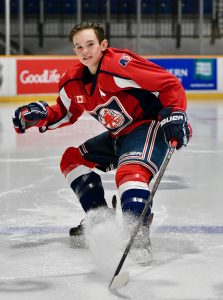NOSM University is pleased to announce a meaningful new partnership with the NoahStrong Organization, which is making a generous donation of $7,500 to support pediatric residents in Northern Ontario. In addition, NoahStrong is investing $12,000 over three years to serve as the title sponsor of the newly renamed NoahStrong Pediatric Conference at NOSM University, an event that brings health professionals together to strengthen child health outcomes across the region.
This collaboration honours and carries forward the legacy of Noah Dugas, a kind and compassionate 13-year-old from North Bay with a profound passion for hockey, whose life was tragically cut short by a sudden and unexpected stroke. Noah’s story continues to touch communities across Canada and shines a light on pediatric stroke, an urgent yet often overlooked health issue.
“Noah’s story is one of love, courage, and community. By supporting NOSM University and becoming the title sponsor of the NoahStrong Pediatric Conference, we hope to spark conversations about pediatric stroke and ensure more families and clinicians are aware of its signs. It means so much to know that Noah’s legacy will inspire learning, awareness, and improved care,” says Jody Dugas, Noah’s Mom and President of the NoahStrong Charitable Organization.
Although stroke is commonly associated with older adults, pediatric stroke affects infants, children, and youth, and remains significantly under-recognized. Similarly, many rare pediatric conditions present with subtle or misunderstood symptoms, contributing to delayed diagnosis and treatment. Noah’s sudden illness, despite being a healthy and active child, underscores the need for greater public awareness, enhanced clinical education, and expanded research across the spectrum of rare childhood health conditions.
“We are profoundly grateful for this generous support from NoahStrong,” says Dr. Tara Baron, Pediatrician and Associate Dean Continuing Education Professional Development at NOSM University. “Their support of NOSM University pediatric residents and their three-year sponsorship of the NoahStrong Pediatric Conference will help health professionals across Northern Ontario deepen their understanding of pediatric stroke and other rare childhood conditions. Noah’s story will inspire clinicians for years to come as they care for children and families across the North.”
The NoahStrong Pediatric Conference at NOSM University will continue to bring together clinicians, educators, researchers, and community partners to advance pediatric knowledge, share emerging practices, and build capacity across Northern Ontario’s unique health-care landscape. The conference will be held October 2, 2026, in Sudbury. Physicians and health-care professionals can visit NOSM University’s Continuing Education and Professional Development at nosm.ca/cepd.
The NoahStrong Pediatric Resident Bursary supports pediatric residents in Northern Ontario who are dedicated to improving health care in Northern Ontario communities. This bursary recognizes residents who demonstrate a commitment to providing compassionate, high-quality care to children while addressing the unique challenges of Northern Ontario medicine.
To learn more about the NoahStrong Organization and how to support their work, please visit noahstrong.ca.



